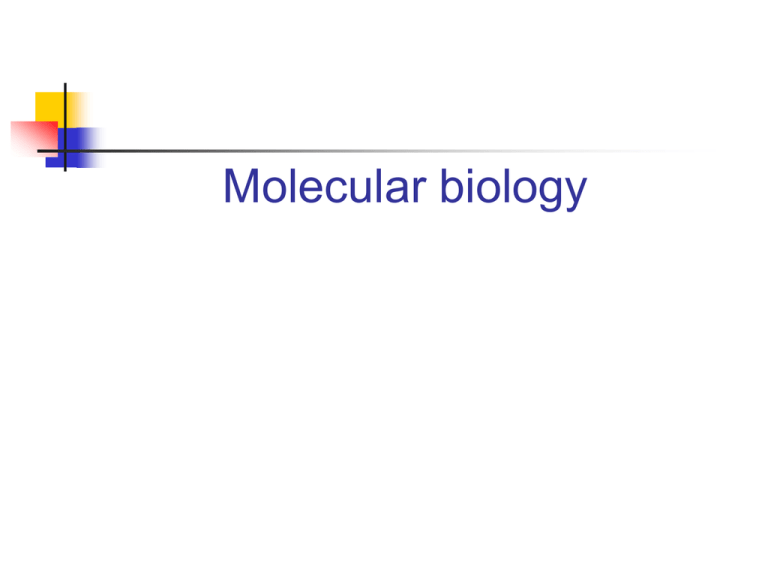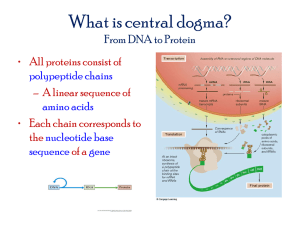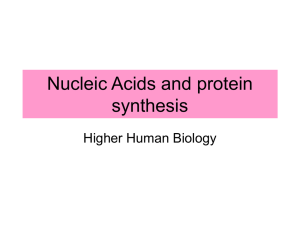Dr Asmat Salim MM 707 Molecular biology
advertisement

Molecular biology Course structure Polymerase Chain Reaction RNA Isolation cDNA Synthesis Amplification Electrophoresis Transfection Which molecules can be analyzed? Genomic DNA mRNA Nucleic acid chemistry DNA and RNA store and transfer genetic information in living organisms. DNA: – major constituent of the nucleus – stable representation of an organism’s complete genetic makeup RNA: – found in the nucleus and the cytoplasm – key to information flow within a cell Why purify genomic DNA? Many applications require purified DNA. Purity and amount of DNA required depends on intended application. Tissue typing for organ transplant Detection of pathogens Human identity testing Genetic research DNA purification challenges 1. Separating DNA from other cellular components such as proteins, lipids, RNA, etc. 2. Avoiding fragmentation of the long DNA molecules by mechanical shearing or the action of endogenous nucleases. Effectively inactivating endogenous nucleases and preventing them from digesting the genomic DNA is a key early step in the purification process. DNases can usually be inactivated by use of heat or chelating agents. DNA purification There are many DNA purification methods. In all cases, one must: 1. 2. 3. 4. Effectively disrupt cells or tissues (usually using detergent) Denature proteins and nucleoprotein complexes (a protease/denaturant) Inactivate endogenous nucleases (chelating agents) Purify nucleic acid target selectively (could involve RNases, proteases, selective matrix and alcohol precipitations) Total Cellular RNA •Messenger RNA (mRNA): 1-5% Serves as a template for protein synthesis • Ribosomal RNA (rRNA): >80% Structural component of ribosomes • Transfer RNA (tRNA): 10-15% Translates mRNA information into the appropriate amino acid What RNA is needed for? Messenger RNA synthesis is a dynamic expression of the genome of an organism. As such, mRNA is central to information flow within a cell. • Size – examine differential splicing • Sequence – predict protein product • Abundance – measure expression levels • Dynamics of expression – temporal, developmental, tissue specificity RNA isolation RNA purification •Total RNA from biological samples – Organic extraction – Affinity purification • mRNA from total RNA – Oligo(dT) resins • mRNA from biological samples – Oligo(dT) resins Total RNA purification • Cells or tissue must be rapidly and efficiently disrupted • Inactivate RNases • Denature nucleic acid-protein complexes • RNA selectively partitioned from DNA and protein RNases • RNases are naturally occurring enzymes that degrade RNA • Common laboratory contaminant (from bacterial and human sources) • Also released from cellular compartments during isolation of RNA from biological samples • Can be difficult to inactivate Protecting against RNases • Wear gloves at all times • Use RNase-free tubes and pipette tips • Use RNase-free chemicals • Pre-treat materials with extended heat (180°C for several hours), wash with DEPC-treated water • Supplement reactions with RNase inhibitors • Include a chaotropic agent (guanidine) in the procedure that inactivate and precipitate RNases and other proteins Organic extraction of total RNA Advantages • Versatile - compatible with a variety of sample types • Scalable - can process small and large samples • Established and proven technology • Inexpensive Disadvantages • Organic solvents • Not high-throughput • RNA may contain contaminating genomic DNA Affinity purification of total RNA Advantages • Eliminates need for organic solvents • Compatible with a variety of sample types (tissue, tissue culture cells, white blood cells, plant cells, bacteria, yeast, etc.) • DNase treatment eliminates contaminating genomic DNA • Excellent RNA purity and integrity RNA analysis Photometric measurement of RNA concentration UV 260 nm Conc=40xOD260 Determination of the RNA concentration [RNA] μg/ml = A260 x dilution x 40.0 where A260 = absorbance (in optical densities) at 260 nm dilution = dilution factor (200) 40.0 = average extinction coefficient of RNA. cDNA Synthesis Template: - Total RNA + - Poly (A) RNA - Specific RNA Priming Oligo dT (18) synthesize complete cDNAs, beginning at the poly A+ tail and ending at the 5 end of the mRNA. Random hexamer Hybridizes somewhere along the mRNA Gene specific primers Specific mRNA but lower yields Reverse Transcriptases (RTs) The reverse transcriptase from the avian myoblastosis virus (AMV-RT): Temperature optimum of activity at 45-50°C. Highly thermostable, can be used at temperatures up to 60°C. Demonstrates DNA exonuclease and RNase activities. The reverse transcriptase from the Moloney murine leukemia virus (MMLV-RT): The optimal working temperature is about 37°C, with a maximum of 42°C. Weaker RNase activity. Normalization Most gene expression assays are based on the comparison of two or more samples and require uniform sampling conditions for comparison to be valid. Many factors can contribute to variability in the analysis of samples, making the results difficult to reproduce between experiments: Sample degradation, extraction efficiency, contamination, Sample concentration, RNA integrity, reagents, reverse transcription Housekeeping genes: ß-actin, ß-tubulin, GAPDH, have often been used as reference genes for normalization. The expression of these genes is constitutively high and that a given treatment will have no effect on the expression level. Amplification (PCR) The Polymerase Chain Reaction PCR – first described in mid 1980’s, Mullis (Nobel prize in 1993) An in vitro method for the enzymatic synthesis of specific DNA sequences Selective amplification of target DNA from a heterogeneous, complex DNA/cDNA population Requires Two specific oligonucleotide primers Thermostable DNA polymerase (Taq DNA polymerase from Thermus aquaticus) dNTP’s Template DNA MgCl2 Sequential cycles of (generally) three steps (temperatures) MgCl2 (mM) 1.5 2 3 4 5 Magnesium Chloride (usually 0.5-5.0mM) Magnesium ions have a variety of effects Mg2+ acts as cofactor for Taq polymerase Mg2+ binds DNA - affects primer/template interactions Mg2+ influences the ability of Taq pol to interact with primer/template sequences More magnesium leads to less stringency in binding Thermal cyclers 29 Introduced in 1986. PCR cyclers available from many suppliers. heated lids adjustable ramping times single/multiple blocks gradient thermocycler blocks Reactions in tubes or 96-well micro-titre plates thin walled tube, volume, cost evaporation & heat transfer concerns0 Temperature control in a PCR thermocycler 94 0C - denaturation 50 – 70 0C - primer annealing 72 0C - primer extension 94 0C - denaturation Step 1: Denaturation dsDNA to ssDNA Step 2: Annealing Primers onto template Step 3: Extension dNTPs extend 2nd strand Vierstraete 1999 PCR Problems Mis-priming Set up reactions on ice Hot-start PCR –holding one or more of the PCR components until the first heat denaturation Manually - delay adding polymerase Polymerase antibodies Touch-down PCR – set stringency of initial annealing temperature high, incrementally lower with continued cycling PCR additives 0.5% Tween 20 5% polyethylene glycol 400 DMSO Primer Design 1. 2. 3. 4. Typically 20 to 30 bases in length Annealing temperature dependent upon primer sequence (~ 50% GC content) Avoid secondary structure, particularly 3’ Avoid primer complementarity (primer dimer) Primer Design Software Many free programs available online OLIGO PRIMER PrimerQuest Primer Design Software 35 Many free programs available online •OLIGO www.oligo.net •PrimerQuest www.eu.idtdna.com/scitools/applications/primerquest •Primer3 www.frodo.wi.mit.edu/primer3 •GeneWorks www.geneworks.com.au •Yeast genome primer design www.yeastgenome.org/cgi-bin/web-primer Primer Dimers • Pair of Primers 5’-ACGGATACGTTACGCTGAT-3’ 5’-TCCAGATGTACCTTATCAG-3’ • Complementarity of primer 3’ ends 5’-ACGGATACGTTACGCTGAT-3’ 3’-GACTATTCCATGTAGACCT-5’ • Results in PCR product Primer 1 5’-ACGGATACGTTACGCTGATAAGGTACATCTGGA-3’ 3’-TGCCTATGCAATGCGACTATTCCATGTAGACCT-5’ Primer 2 Rules of thumb for PCR conditions Add an extra 3-5 minute (longer for Hot-start Taq) to your cycle profile to ensure everything is denatured prior to starting the PCR reaction Approximate melting temperature (Tm) = [(2 x (A+T)) +(4 x (G+C))]ºC If GC content is < 50% start 5ºC beneath Tm for annealing temperature If GC content ≥ 50% start at Tm for annealing temperature Extension @ 72ºC: rule of thumb is ~500 nucleotide per minute. Use 3 minutes as an upper limit without special enzymes Typical PCR Temps/Times Initial denaturation 90o – 95o C 1 – 3 min Denature 90o – 95o C 0.5 – 1 min Primer annealing 45o – 65o C 0.5 – 1 min Primer extension 70o – 75o C 0.5 – 2 min Final extension 70o – 75o C 5 – 10 min Stop reaction 4o C or 10 mM EDTA Hold 25 – 40 cycles DNA Gel Electrophoresis Agarose Agarose is a polysaccharide consisting of a linear polymer (repeating units) of D-galactose and 3,6-anhydro L-galactose The movement of molecules through an agarose gel is dependent on the size and charge of molecules and the pore sizes present in the agarose gel. At neutral pH, molecules migrate toward the anode when an electric field is applied across the gel. Small, highly negatively charged molecules migrate faster through agarose gels than large, less negatively charged molecules. Rates can also be effected by the pore size of the agarose gel. Decreasing pore sizes increases the separation of small and large molecules during electrophoresis. Pore size can be decreased by increasing the percentage of agarose in the gel. TBE or TAE Buffers Tris helps to maintain a consistent pH of the solution. EDTA chelates divalent cations like magnesium. This is important because most nucleases require divalent cations for activity. Ethidium Bromide A fluorescent dye is added to agarose gels. It intercalates between the bases of DNA, allowing DNA fragments to be located in the gel under UV light. The intensity of the band reflects the concentration Because of its interaction with DNA, ethidium bromide is a powerful mutagen. Always handle all gels and gel equipment with gloves. Agarose gels with Ethidium Bromide must be disposed as hazardous waste in the labelled container. Add loading dye to all samples. Loading dye contains xylene cyanol as a tracking dye to follow the progress of the electrophoresis as well as glycerol to help the samples sink into the well.








